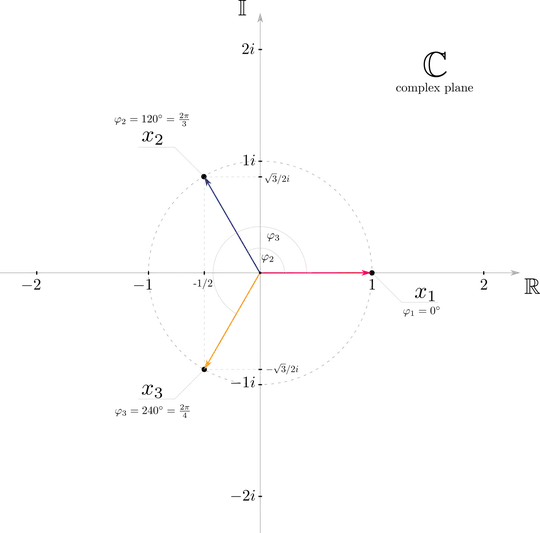SQUARE ROOT
Let's say that I have:
\begin{align*} x^2 &= 9 \end{align*}
And I $\sqrt{\phantom{x}}$ an entire equation to get:
\begin{align*} x_{1,2} &= \sqrt{9}\\ x_{1} &= +3\\ x_{2} &= -3 \end{align*}
Experience and "fundamental theorem of algebra" thought me that:
There are always two square roots ($x_1$, $x_2$)!
Experience thought me that:
Product of mixed roots doesn't return back the original: \begin{align*} x_1 \cdot x_2 &= -3 \cdot 3 = -9\\ x_2 \cdot x_1 &= 3 \cdot (-3) = -9 \end{align*}
Experience also thought me that:
Only if roots are multiplied by itself they return back the result: \begin{align*} x_1 \cdot x_1 &= 3 \cdot 3 = 9\\ x_2 \cdot x_2 &= (-3) \cdot (-3) = 9 \end{align*}
CUBE ROOT
Then there comes this:
\begin{align*} x^3 &= 1\\ \end{align*}
If I $\sqrt{\phantom{x}}$ an entire equation I get:
\begin{align*} x_{1,2,3} &= \sqrt[3]{1}\\ x_1 &= 1\\ x_2 &= \text{???}\\ x_3 &= \text{???} \end{align*}
Here I have no experience whatsoever but "fundamental theorem of algebra" says that:
There are always three cube roots ($x_1$, $x_2$, $x_3$)!
Now pay attention! Like for square root it should be true that:
If roots $x_1$, $x_2$, $x_3$ are multiplied by itself they return $1$. Their mixed products will probably return something else. \begin{align*} x_1 \cdot x_1 \cdot x_1 = 1\\ x_2 \cdot x_2 \cdot x_2 = 1\\ x_3 \cdot x_3 \cdot x_3 = 1 \end{align*}
So at this point everybody's already rushing to their paper and drawing this complex plane:
And in complex plane:
If we multiply complex numbers, length of their position vectors multiply and their angles sum up.
So everybody will now draw $x_1$ on the $\mathbb{R}$ axis and tell me that this is the first root. I agree with that. Then they say:
Length of a position vector of other two roots ($x_2$, $x_2$) must be $1$ as well.
And I agree with that. But what they say now, I can't agree with no matter how I look at it. They say:
Because according to "fundamental theorem of algebra" there are three cube roots, and we will multiply them in order to get to $1$, angle between them must be $120^\circ$. We now start at $1$ and if we do a full circle we end at $1$ again. Woila! Problem solved...
I can't agree with this explanation as is because this only holds for $x_1$. If I take $x_1$ and make a full circle I end up getting $1$. But with $x_2$ and $x_3$ my starting point is not $1$. Starting points are actually:
\begin{align*} \text{starting point for $x_2$:} \hspace{5mm} -\frac{1}{2} - \frac{\sqrt{3}}{2}i \\ \text{starting point for $x_3$:} \hspace{5mm} -\frac{1}{2} + \frac{\sqrt{3}}{2}i \end{align*}
And in case of $x_2$ and $x_3$ when we do a full circle we don't end up getting $1$, but we geometricaly looking end at positions:
\begin{align*} -1/2 - \sqrt{3}/2 i \\ -1/2 + \sqrt{3}/2 i \end{align*}
If the starting positions are as I state they are, angle that we need in order to get to the $1$ should be $\pm240/3 = \pm80^\circ$.
But then why does this explanation that they use, work? At the end of the day e.g. $x_2$ solves the problem:
\begin{align*} \left(x_2\right)^3 &= 1\\ \left( -\frac{1}{2} + \frac{\sqrt{3}}{2} i \right)^3 &= 1\\ \left( -\frac{1}{2} + \frac{\sqrt{3}}{2} i \right) \left( -\frac{1}{2} + \frac{\sqrt{3}}{2} i \right) \left( -\frac{1}{2} + \frac{\sqrt{3}}{2} i \right)&= 1\\ \left(\frac{1}{4} - \frac{\sqrt{3}}{4}i - \frac{\sqrt{3}}{4}i + \frac{3}{4}i^2\right) \left( -\frac{1}{2} + \frac{\sqrt{3}}{2} i \right) &= 1\\ \left(\frac{1}{4} - \frac{2\sqrt{3}}{4}i - \frac{3}{4}\right) \left( -\frac{1}{2} + \frac{\sqrt{3}}{2} i \right) &= 1\\ \left(-\frac{1}{2} - \frac{\sqrt{3}}{2}i\right) \left( -\frac{1}{2} + \frac{\sqrt{3}}{2} i \right) &= 1\\ \frac{1}{4} - \frac{\sqrt{3}}{4} i + \frac{\sqrt{3}}{4} i - \frac{3}{4} i^2 &= 1\\ \frac{1}{4} + \frac{3}{4} &= 1 \end{align*}
I am sure there is something wrong with the explanation everybody are using but it is correct to assume roots are $120^\circ$ appart...
Probably the point here is not about making a full circle at all! Like most of the people say. It must be about adding conjugate pairs so that artifficialy we create enough roots to satisfy fundamental theorem of algebra! Thats all! So odd number root $3$ was historicaly first one that forced us to get out of the horizontal axis in complex plane and invent complex roots...
Can anyone present a proper explanation of why we choose $120^\circ$ for cube roots?
